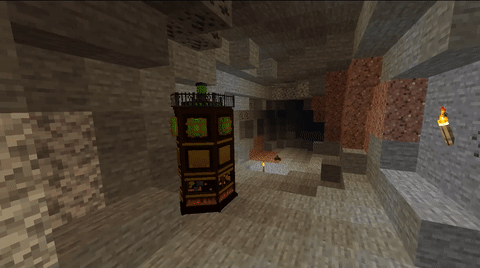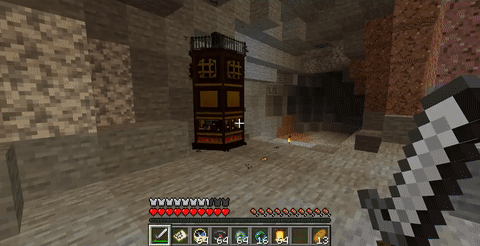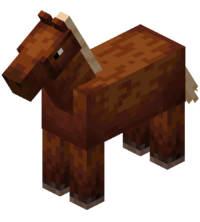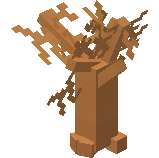Creating your Tardis
The Tardis is obtained through an immersive process. This process are different for the 1.14.4 and 1.12.2 versions.
1.14.4 Process
Finding a broken Tardis
Figure 1 - A Broken down Tardis Exterior
In the 1.14.4 versions, Tardises are no longer grown from a crafted Tardis Coral block. Instead, they can be found underground across all biomes in the Overworld.
It’s speculated that this was caused by various Tardises falling out of the Time Vortex due to an unknown cause and that they sustained heavy damage to all systems.
Interacting with a Tardis
As outlined in the Introduction, each Tardis will have a unique emotional personality and may exhibit different emotions when interacted with.
Initially, crashed Tardises will be vulnerable and will be hesitant and fearful of any outsiders, much like a cornered or wounded creature. The exterior will produce sparks and will produce a pulsating, faint glow. Players or entities cannot enter the Tardis in any form at this stage.
The player will need to convince the Tardis to open for them in order to gain access. Most Tardises are known for having a passion for exploration and adventure, so the player may want to appeal to these emotions.
Gifting Items
Figure 2 - A player gaining the loyalty of a broken Tardis.
One way the player can interact with the Tardis is through giving it items it likes, especially items related to exploration/adventure. This is done by right clicking with an item on the Tardis exterior. If the Tardis likes the item, it will produce heart particles. A successful gift will also increase the Tardis’ loyalty to the player, which will be outlined in further detail here: Tardis Psychology (WIP).
Some items a Tardis may like include:
- Filled Map
- Ender Pearl
- Ender Eye
- Bells
- Clocks
- Compass
- And more in the future
Forced Entry
The player can also choose to forcibly enter a broken Tardis, by right clicking with a lead on a Horse, then right clicking with the lead onto the broken Tardis exterior. However, this will bring negative consequences to the Tardis’ mood and loyalty. The Tardis will likely hate the player and seek to not land accurately, or throw them out.
1.12.2 Process
|
Figure 2 - A Tardis Coral |
As of 0.0.8A, players are required to grow their own Tardis to create it. This is done by crafting a Tardis coral and Sub-system components.
Stage 1 - Growing the Tardis Coral
To grow the Tardis, place down the Tardis coral on any block and wait two Minecraft days. After two days has past, the player will receive a Tardis key and the player’s Tardis will materialize in the place of the coral.
Notes:
- Over the period of two Minecraft days, the Tardis Coral will show progressive growth with four major stages. See the following images in the Gallery.
- Breaking a coral that is undergoing growth will reset the growth timer and revert it to its first growth stage.
- The player can only grow one Tardis from a coral block.
- If additional coral blocks are placed down after the growth of the first Tardis, they will not continue to grow. (As of 0.0.9B, this feature is bugged but will be rectified in future versions)
- If the player's inventory is full at the time of the key being given, the Tardis key will NOT be given to the player.
- If the player is offline when their Tardis has finished growing (for instance, on a multiplayer server), the Tardis key will be stored in the game and given to the player upon logging back in, provided their inventory was not full.
- If the player is in a Rift Chunk, the coral growth time is reduced to 1 Minecraft Day
- The command
/tardis growcan be used to instantly grow the Tardis (provided the player is looking at the coral’s hitbox and has the right permissions).- Each individual growth stage can be viewed with the command
/time set 23999
- Each individual growth stage can be viewed with the command
Stage 2 - Repairing Sub-system components
Upon mature growth, the Tardis will provide all sub-systems, with each sub-system having a random durability value. Thus, the player must gather resources to repair the sub-system components to prolong the life of the Tardis.




